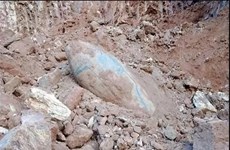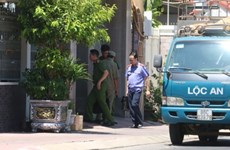Dyke violation crackdown in Hanoi
Dyke violations are reducing their effectiveness in the approaching
storm season yet little has been done to resolve the issue, said Hanoi’s
Flood and Dyke Management Department director Do Duc Thinh.
Dyke violations are reducing their effectiveness in the approaching
storm season yet little has been done to resolve the issue, said Hanoi’s
Flood and Dyke Management Department director Do Duc Thinh.
"Serious violations are being reported, such as the presence of houses and other solid constructions on the dykes, but so far they have not resulted in a clearance of the dykes," Thinh said.
Statistics showed there were 4,700 violations of the city's 20 dyke lines, which cover 470km; 440 violations were discovered last year.
"Though statistics show 177 violations in the first six months of this year, the real number is higher," Thinh said. "New violations are emerging every day while local authorities have not resolved the old ones."
Most violations involved construction of houses, workshops, stocks and brick-kilns on dykes. Others included dumping construction rubbish, removing gravel and digging irrigation channels.
Violations occurred primarily in the Hong and Day riverside districts, including Ung Hoa, Dan Phuong, Phu Xuyen and Hoai Duc districts.
"About 40 percent of violations occurred along a 36km stretch in Ung Hoa district."
Pham Van Hien, head inspector of the Ministry of Agriculture and Rural Development said some districts have not taken drastic enough measures to handle the situation, being content to settle the simple violations and ignore the rest. Some offenders continued violating for years and years.
In fact, he said, Phu Xuyen district's Minh Phu, Van Nhan and Hong Thai communes had actually signed contracts with individuals to build 35 brick kilns on riverbanks, which was a direct infringement under the Dyke Law.
In addition, brick kiln owners illegally exploit dyke land and transport materials.
Thinh said local authorities had carried out inspections of the city's dyke system which resulted in the removal of illegal homes and other buildings.
"However, a lack of strict punishment on the violations makes the situation complicated," he said, adding clearances requires co-ordination.
"The best solution is to closely follow up with dyke management and to continuously improve the dykes before and after the rainy season," Thinh said.
He also recommended Hanoi create a resettlement land bank for families whose houses were removed from the dyke system./.
"Serious violations are being reported, such as the presence of houses and other solid constructions on the dykes, but so far they have not resulted in a clearance of the dykes," Thinh said.
Statistics showed there were 4,700 violations of the city's 20 dyke lines, which cover 470km; 440 violations were discovered last year.
"Though statistics show 177 violations in the first six months of this year, the real number is higher," Thinh said. "New violations are emerging every day while local authorities have not resolved the old ones."
Most violations involved construction of houses, workshops, stocks and brick-kilns on dykes. Others included dumping construction rubbish, removing gravel and digging irrigation channels.
Violations occurred primarily in the Hong and Day riverside districts, including Ung Hoa, Dan Phuong, Phu Xuyen and Hoai Duc districts.
"About 40 percent of violations occurred along a 36km stretch in Ung Hoa district."
Pham Van Hien, head inspector of the Ministry of Agriculture and Rural Development said some districts have not taken drastic enough measures to handle the situation, being content to settle the simple violations and ignore the rest. Some offenders continued violating for years and years.
In fact, he said, Phu Xuyen district's Minh Phu, Van Nhan and Hong Thai communes had actually signed contracts with individuals to build 35 brick kilns on riverbanks, which was a direct infringement under the Dyke Law.
In addition, brick kiln owners illegally exploit dyke land and transport materials.
Thinh said local authorities had carried out inspections of the city's dyke system which resulted in the removal of illegal homes and other buildings.
"However, a lack of strict punishment on the violations makes the situation complicated," he said, adding clearances requires co-ordination.
"The best solution is to closely follow up with dyke management and to continuously improve the dykes before and after the rainy season," Thinh said.
He also recommended Hanoi create a resettlement land bank for families whose houses were removed from the dyke system./.













